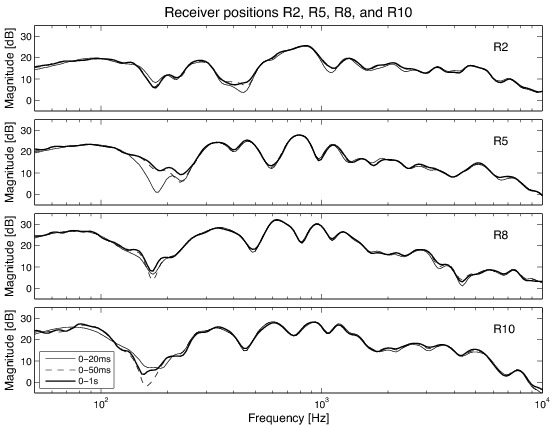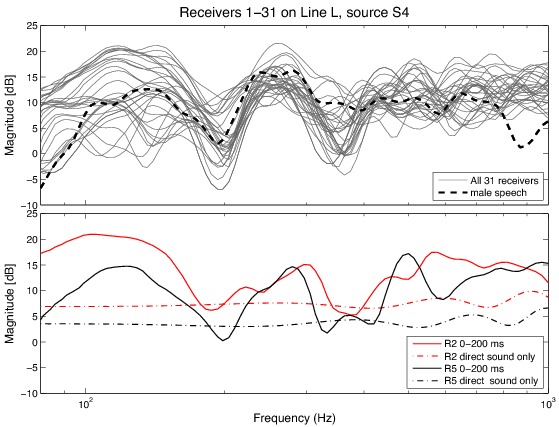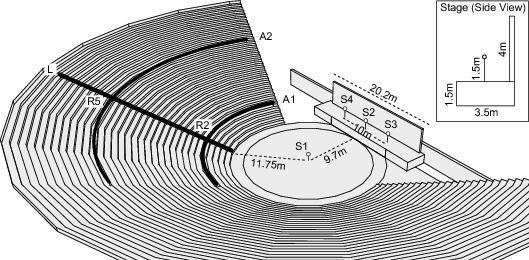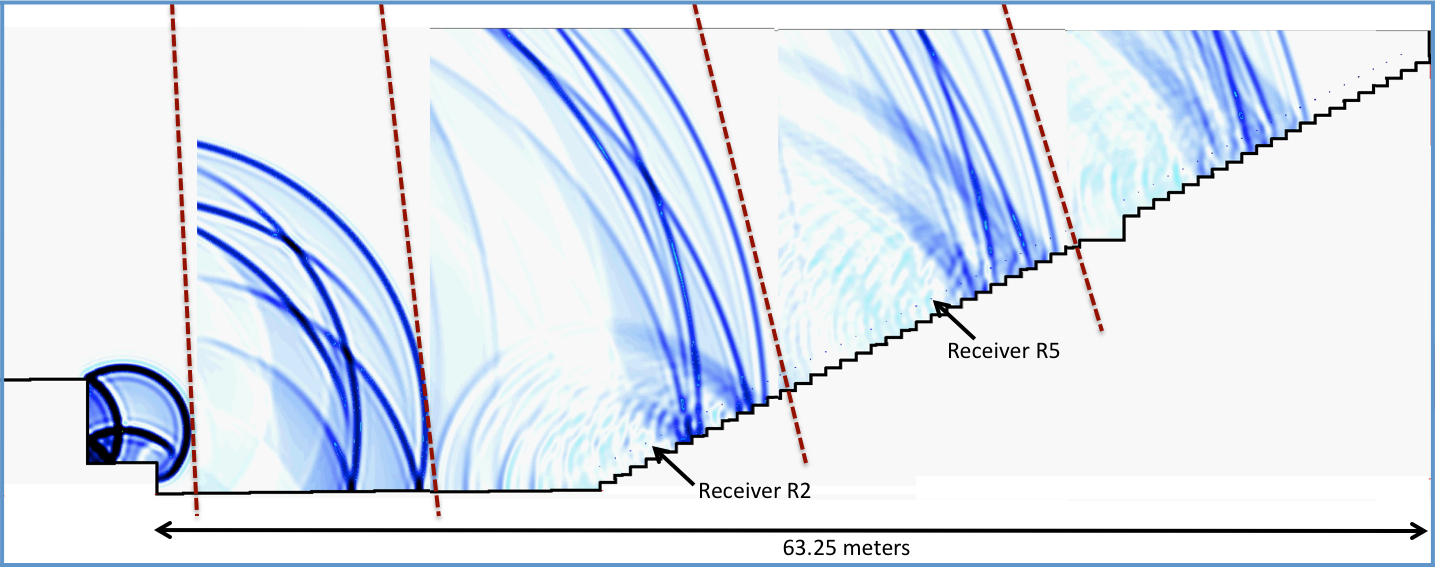- Details
- Published: 09 January 2013
The capability of the ancient theatres to amplify speech has been fascinating researchers of acoustics for decades. Many different explanations have been proposed to explain why even at the back row speech is clear and well audible. The speech intelligibility is very high all over the huge audience area [1].
The most extensive, but unfortunately not very well known, study of the acoustics of the ancient theatres has been presented by Canac [2]. His book has in many aspects made a prominent contribution, especially considering that the book was published in the 1960s. He studied different geometries with image sources and showed how the direct sound and early reflections from the orchestra and the back wall of the stage are important to amplify the voices of ancient actors. Moreover, he proposed that sound waves might travel along the circular seating rows, i.e., by bending along the curved surfaces. However, he misunderstood the contribution of lateral reflections by proposing that they should be suppressed and he did not discuss the backscattering of sound from the seating rows at all.
Perhaps the most well-known explanation of the acoustics of ancient theatres has been published by Declercq and Dekeyser [3]. They performed acoustic simulations on an Epidaurus model using a geometric acoustic modelling method incorporating multiple orders of diffraction. They concluded that the sound is backscattered from the cavea to the audience making the audience receive sound, not only from the front, but also backscattered sound from behind. Thus Declercq and Dekeyser concluded that the seat rows act as a high-pass filter amplifying high frequencies more than low frequencies and the cross-over frequency of such filtering depends on the periodicity of seat rows, in Epidaurus it is around 500 Hz. However, the measurement results by Psarras et al. [4] do not support the findings with simulations of Declercq and Dekeyser. Frequency responses in Fig. 1 do not show any considerable attenuation of the frequencies below 500 Hz. Instead, the low frequencies below 150 Hz are emphasized, although at approximately 180 Hz the frequency responses contain a dip, probably due to the backscattered sound from the seating rows.
Our explanation on the acoustics of Epidaurus
We studied the acoustics of Epidaurus with 2D and 3D FDTD simulations [5]. The simulation results matched quite well to the measurements [4], in particular at low frequencies. Based on the analysis of the in-situ measurements, visits, and simulations, we explain the great acoustics for speech as follows.
The strong sound and high speech intelligibility requires high enough signal to noise ratio. Epidaurus is located at the peaceful countryside in Greece. Therefore, the background noise in the venue is considerably low and signal to noise ratio is reasonably high, in particular at ancient times when the stage building blocked the excess noise from the valley.
In addition to unobstructed direct sound, the early reflections are very important for good speech intelligibility [6]. The reflections from stage wall, orchestra, seating rows and backscattering of the seating rows arrive to the listener considerably fast after the direct sound. In addition, they are all from hard and reasonably flat surfaces, thus they are well fused to the direct sound, resulting in much stronger and louder sound [7]. The sound power in speech is carried by the vowels, which are harmonic signals. Figure 2 shows the comparison of the frequency responses from the stage to all seat rows with average spectrum of 10 s of anechoic male speech. Below 500 Hz, due to backscattering and early reflections, Epidaurus amplifies the power carrying frequencies for vowels in male speech, i.e., fundamental frequency F0 (125-140 Hz) and first harmonics (250-290 Hz and 375-420 Hz). The information in vowels is in three main formant regions. For all vowels they are between 300 and 3000 Hz, i.e., the highly amplified frequency region in Epidaurus due to backscattering from higher seating rows. The seating rows are 0.367 m high, i.e., effectively reflecting frequencies higher than f = 340 / (2*0.367) = 463 Hz (at least half of the wavelength).
The late reverberation is detrimental for speech intelligibility, because reverberation masks and blurs transients and consonants in speech. The Epidaurus has short late reverberation and it is at low level, mainly because the venue is not an enclosed space. Moreover, there is hardly any reverberation at low frequencies, which can be clearly heard from a video of an impulse response measurement
To summarize, the early reflections fuse to direct sound and raise the overall sound power level. However, at low frequencies periodic seating rows filter out the frequencies with no excitation in speech, but amplify the fundamental and first harmonics of male speech, thus raising signal to noise ratio. In addition, there is hardly any late reverberation to muddy sound at low frequencies. At higher frequencies from 500 to 4000 Hz, the seating rows amplify considerably the sound, resulting in high speech intelligibility all over the audience area.
References
[1] R S Shankland: Acoustics of Greek theatres. Physics Today 26(10):30-35, 1973. BibTeX / Info
@article{sha73,
author = "R. S. Shankland",
date-added = "2012-04-27 16:01:48 +0300",
date-modified = "2012-04-27 16:03:19 +0300",
journal = "Physics Today",
number = 10,
pages = "30-35",
title = "Acoustics of Greek theatres",
volume = 26,
year = 1973
}
[2] F Canac. L'acoustique des théâtres antiques : ses enseignements. Centre national de la recherche scientifique, 1967. BibTeX / Info
@book{canac67,
address = "Paris",
author = "F. Canac",
date-added = "2012-03-14 22:09:45 +0200",
date-modified = "2012-03-14 22:12:20 +0200",
publisher = "Centre national de la recherche scientifique",
title = "L'acoustique des th{\'e}{\^a}tres antiques : ses enseignements",
year = 1967
}
[3] N F Declercq and C S A Dekeyser: Acoustic diffraction effects at the Hellenistic amphitheatre of Epidaurus: Seat rows responsible for the marvellous acoustics. Journal of the Acoustical Society of America 121(4):2011-2022, 2007. BibTeX / Info
@article{dec07,
author = "N.F. Declercq and C.S.A. Dekeyser",
date-added = "2012-03-14 21:58:44 +0200",
date-modified = "2012-03-14 22:00:03 +0200",
journal = "Journal of the Acoustical Society of America",
number = 4,
pages = "2011-2022",
title = "Acoustic diffraction effects at the Hellenistic amphitheatre of Epidaurus: Seat rows responsible for the marvellous acoustics",
volume = 121,
year = 2007
}
[4] S Psarras, P Hatziantoniou, M Kountouras, N -A Tatlas, J N Mourjopoulos and D Skarlatos: Measurements and Analysis of the Epidaurus Ancient Theatre Acoustics. Acta Acustica united with Acustica 99(1):30-39, 2013. BibTeX / Info
@article{psa13aaua,
author = "S. Psarras and P. Hatziantoniou and M. Kountouras and N.-A. Tatlas and J. N. Mourjopoulos and D. Skarlatos",
date-added = "2013-02-01 16:35:16 +0200",
date-modified = "2013-02-01 16:40:36 +0200",
journal = "Acta Acustica united with Acustica",
month = "January/February",
number = 1,
pages = "30-39",
title = "Measurements and Analysis of the Epidaurus Ancient Theatre Acoustics",
volume = 99,
year = 2013
}
[5] T Lokki, A Southern, S Siltanen and L Savioja: Acoustics of Epidaurus - studies with room acoustics modelling methods. Acta Acustica united with Acustica 99(1):40-47, 2013. URL BibTeX / Info
@article{lok13aaua,
author = "T. Lokki and A. Southern and S. Siltanen and L. Savioja",
date-added = "2013-02-01 16:33:11 +0200",
date-modified = "2013-02-04 10:57:33 +0200",
journal = "Acta Acustica united with Acustica",
month = "January/February",
number = 1,
pages = "40-47",
title = "Acoustics of {E}pidaurus - studies with room acoustics modelling methods",
url = "http://dx.doi.org/10.3813/AAA.918586",
volume = 99,
year = 2013
}
[6] J S Bradley, H Sato and M Picard: On the importance of early reflections for speech in rooms. Journal of the Acoustical Society of America 113(6):3233-3244, 2003. BibTeX / Info
@article{bra03,
author = "J. S. Bradley and H. Sato and M. Picard",
date-added = "2012-04-28 19:23:59 +0300",
date-modified = "2012-04-28 22:02:00 +0300",
journal = "Journal of the Acoustical Society of America",
number = 6,
pages = "3233-3244",
title = "On the importance of early reflections for speech in rooms",
volume = 113,
year = 2003
}
[7] T Lokki, J Pätynen, S Tervo, S Siltanen and L Savioja: Temporal envelope preserving reflections surrounding the listener make engaging acoustics. Journal of the Acoustical Society of America 129(6):EL223-EL228, June 2011. URL BibTeX / Info
@article{lok11jasael,
author = {T. Lokki and J. P{\"a}tynen and S. Tervo and S. Siltanen and L. Savioja},
date-added = "2012-04-28 15:23:43 +0300",
date-modified = "2013-02-04 10:57:05 +0200",
journal = "Journal of the Acoustical Society of America",
month = "June",
number = 6,
pages = "EL223-EL228",
title = "Temporal envelope preserving reflections surrounding the listener make engaging acoustics",
url = "http://dx.doi.org/10.1121/1.3579145",
volume = 129,
year = 2011
}







